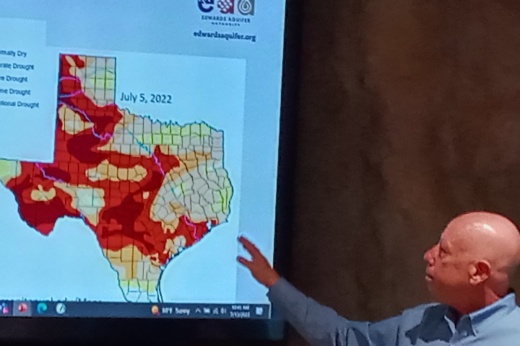Citing dropping water well levels, Edwards Aquifer Authority officials said on July 13 that many San Antonio-area residents reliant on Edwards Aquifer water could get moved to a higher level of conservation measures later this summer if the region fails to see significant rainfall anytime soon.
In a media presentation at the agency’s Education Outreach Center in far north Bexar County, EAA staff said the J-17 well—used by the authority to record aquifer level changes—had a July 12 reading of 632.6 feet above mean sea level, or MSL, a drop of 4.1 feet in the previous 10 days.
For context, EAA data shows the water level in the J-17 well—located at Joint Base San Antonio-Fort Sam Houston—stood at 670.6 feet above MSL on July 13, 2021. The well’s historical monthly average water level has been 660.3 feet.
According to the EAA, the current 10-day water level average at the J-17 well was 634.7 on July 13; the agency uses the 10-day average to determine whether a certain stage of conservation measures are required. The EAA has put Stage 3 water conservation practices into effect.
“We manage our critical period based on the 10-day average water level, not just the water level of that day,” said Paul Bertetti, the EAA’s senior director of aquifer science research and modeling.
Bertetti said the J-17 well water level has been declining for much of this year, mostly because of a lack of rainfall on the aquifer recharge zone.
“I think we’re below something like 12 and a half inches [of rain] below normal this year, so that’s significant,” Bertetti said.
The EAA has reported local water level declines elsewhere, including the J-27 well in Uvalde, and inflow discharges of the Comal and San Marcos springs.
Considering historical water levels and current Edwards Aquifer water usage, Bertetti said further reductions in water levels this year could prompt the EAA to enact Stage 4 restrictions by the end of August, even if the San Antonio area were to get solid rainfall in the immediate future.
Bertetti also said much of Texas is officially in a drought, with parts of East Texas having dropped further below normal historical rainfall levels between early June and early July. He added that conditions in West and Central Texas, too, are worsening this year.
According to a short-range weather outlook provided by the National Weather Service, less than average rainfall is expected in Texas for the rest of July into August, Bertetti said. The same trend of mostly dry weather holds true for most of the U.S. Southern Plains, according to the NWS outlook.
“This is probably because of continuing La Niña conditions, so we should not expect major or significant rainfall to get us out of these current drought conditions,” Bertetti said.
EAA officials said whenever their agency declares a critical period of water use restrictions, the authority aims to work with well owners and groundwater permit holders to regulate their rate of water pumped from the aquifer.
But the EAA leaves it to municipalities within the authority’s jurisdiction to regulate certain water uses, such as lawn irrigation, during periods of little to no rain.
Officials with the San Antonio Water System, the largest EAA groundwater permit holder, said customers are staying with Stage 2 watering rules.
EAA staffers said their July 13 media presentation is similar to a briefing that they periodically provide to the authority’s board of directors.
EAA Executive Director Roland Ruiz said one goal behind such presentations is to inform community members of the agency’s history, practices and objectives as well as the area’s geography and climate.
Ruiz added there is a heightened awareness about the aquifer because of drought conditions being felt statewide. Ruiz also said it is important for people to realize a need for balance in meeting rising water demands of a growing population.
According to Ruiz and his EAA colleagues, this is also why the authority recently opened its Education Outreach Center, which is designed to both help the agency with its ongoing scientific research and assist the public in better understanding the aquifer and how human activity affects it.
“We’re learning what we can do in terms of practices to improve the sustainability of the system,” Ruiz said.





